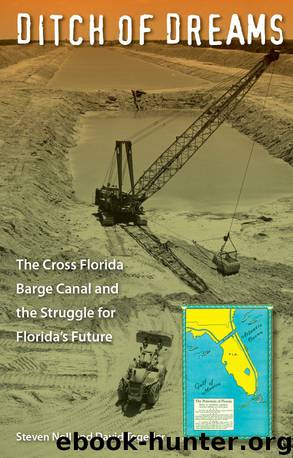Ditch of Dreams by Steven Noll & David Tegeder

Author:Steven Noll & David Tegeder
Language: eng
Format: epub
Publisher: University Press of Florida
Published: 2009-03-15T16:00:00+00:00
6
Floating Logs, Dying Trees, and Clogging Weeds
During his legendary campaign for the United States Senate in 1970, Lawton Chiles walked the length of the state to take the pulse of his fellow Floridians. By June, on the nineteenth day of his journey, Chiles reached Silver Springs, feeling “pretty good, realizing that instead of pounding the pavement … I would be sitting and riding on the water.” While traveling along the Silver and Ocklawaha rivers, Chiles felt pleasantly surprised “that the damage further up the river was not really as great as I had imagined it would be.” He quickly reversed his judgment, however, upon reaching Rodman Reservoir. There he not only encountered the crusher, but the devastation it wrought. Calling the machine a “colossal failure,” Chiles saw the residue of trees supposedly pressed “into the muck to get rid of them.” Instead, he noted, “for the last year and a half they’ve been popping up like corks and the Corps is now having to spend tremendous sums of money keeping a dredge out picking up the logs, piling them on the banks for burning.” For Chiles, the situation was fraught with mistakes, representing “somebody’s grandiose idea [that] just didn’t pan out, and the taxpayer pays.”1
Nearly everyone who encountered the Rodman Reservoir in the late 1960s commented on the environmental destruction wrought by the crusher. While observers acknowledged a wide range of problems associated with canal construction, they consistently focused on the logs that continually popped to the surface of the reservoir. This suggested that the crusher was not only inherently destructive, but inefficient as well. Built specifically for the project, the crusher was designed to smash trees “into the relatively soft ground so that even the biggest trees will not float when the reservoir fills.” Yet it dramatically failed to deliver that promise. As Florida Audubon’s Bill Partington remarked, “it would take up to three years to clear the log jam mess they have created at the so-called recreation pools.” Standing as an unsightly monument to government waste, Rodman Pool did contain a silver lining for environmentalists, for it convinced many neutral observers to oppose the project. According to Partington, “several told me that although they had originally backed the canal, in view of the … general mess of the remaining waterway itself (logs and other debris which make motor boating hazardous) … if they had to do it all over again, they would oppose the project with everything they had.”2
The literal logjam provided opponents a significant opportunity. The persistent problem of logs breaking the placid surface of the reservoir created a moment that not only verified earlier scientific concerns but captured considerable public interest. In December 1968, critics appealed to the press, especially NBC News, to publicize the story. Partington boasted that “we encouraged them” to arrive in Silver Springs and fly over the canal: “Bob Lissit of NBC had said he wanted shots of someone in a boat talking about the natural river. They used Dr. David Anthony of [the] University of Florida and myself for that part.
Download
This site does not store any files on its server. We only index and link to content provided by other sites. Please contact the content providers to delete copyright contents if any and email us, we'll remove relevant links or contents immediately.
| Acoustics | Bridges |
| Earthwork Design | Environmental |
| Fire Science | Highway & Traffic |
| Hydrology | Remote Sensing |
| Seismic Design | Structural |
| Structural Dynamics | Surveying & Photogrammetry |
| Transportation |
Whiskies Galore by Ian Buxton(41710)
Introduction to Aircraft Design (Cambridge Aerospace Series) by John P. Fielding(33011)
Small Unmanned Fixed-wing Aircraft Design by Andrew J. Keane Andras Sobester James P. Scanlan & András Sóbester & James P. Scanlan(32678)
Craft Beer for the Homebrewer by Michael Agnew(18072)
Turbulence by E. J. Noyes(7887)
The Complete Stick Figure Physics Tutorials by Allen Sarah(7257)
Kaplan MCAT General Chemistry Review by Kaplan(6811)
The Thirst by Nesbo Jo(6748)
Bad Blood by John Carreyrou(6467)
Modelling of Convective Heat and Mass Transfer in Rotating Flows by Igor V. Shevchuk(6348)
Learning SQL by Alan Beaulieu(6152)
Weapons of Math Destruction by Cathy O'Neil(6074)
Man-made Catastrophes and Risk Information Concealment by Dmitry Chernov & Didier Sornette(5865)
Digital Minimalism by Cal Newport;(5576)
Life 3.0: Being Human in the Age of Artificial Intelligence by Tegmark Max(5395)
iGen by Jean M. Twenge(5293)
Secrets of Antigravity Propulsion: Tesla, UFOs, and Classified Aerospace Technology by Ph.D. Paul A. Laviolette(5231)
Design of Trajectory Optimization Approach for Space Maneuver Vehicle Skip Entry Problems by Runqi Chai & Al Savvaris & Antonios Tsourdos & Senchun Chai(4949)
Electronic Devices & Circuits by Jacob Millman & Christos C. Halkias(4859)
